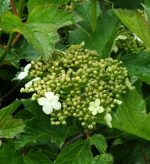 European cranberry a large deciduous suckering shrub native to Europe and North Africa and northern Asia where it is found in wet, swampy sites. It was introduced into the North America as an ornamental and is used as a specimen, and in foundation plantings, mixed borders, hedges and screens but escaped cultivation and has become invasive in some states. Plants grow 8-12’ tall and have coarsely toothed, three-lobed leaves that are dark green until fall when they turn red or red –purple. In late spring to early summer 3.5” wide terminal clusters of small white fertile flowers surrounded by showy sterile flowers appear and are followed by edible red berry-like fruit that are attractive to birds and other wildlife. Plants like full sun to part shade and average, moist, well-drained soil. USDA Hardiness Zones 3-8.
European cranberry a large deciduous suckering shrub native to Europe and North Africa and northern Asia where it is found in wet, swampy sites. It was introduced into the North America as an ornamental and is used as a specimen, and in foundation plantings, mixed borders, hedges and screens but escaped cultivation and has become invasive in some states. Plants grow 8-12’ tall and have coarsely toothed, three-lobed leaves that are dark green until fall when they turn red or red –purple. In late spring to early summer 3.5” wide terminal clusters of small white fertile flowers surrounded by showy sterile flowers appear and are followed by edible red berry-like fruit that are attractive to birds and other wildlife. Plants like full sun to part shade and average, moist, well-drained soil. USDA Hardiness Zones 3-8.
The following plants are recommended as alternatives:
Oakleaf Hydrangea (Hydrangea quercifolia)
Native to wooded slopes and shaded rocky outcroppings from Georgia to Florida and Mississippi, oakleaf hydrangea is a deciduous shrub with large conical panicles of white sepals and fertile flowers beginning in June. The leaves are up to eight inches long and often turn red to burgundy in the fall. USDA Hardiness Zones 5-9
Winterberry (Ilex verticillata)
Valued for its bright red berries that persist into winter, winterberry is a deciduous holly and grows up to 12’ tall. It is native to low woods, swamps, and wetland margins from Nova Scotia to Minnesota, south to Florida and Arkansas. USDA Hardiness Zones 3-9
Scarlet Elder (Sambucus racemosa)
With an upright arching form, this deciduous shrub grows 4-8’ tall and has clusters of white flowers on zigzag twigs from early to midspring followed by scarlet berries in summer. The pinnately divided leaves are dark green in summer before turning yellow in the fall. Native to Open woods, woodlands borders, streambanks and roadsides from Newfoundland to British Columbia, south to North Carolina, Minnesota, and California. USDA Hardiness Zones 3-7
Squashberry (Viburum edule)
Also known as mooesberry, this small deciduous shrub grow 2-12’ tall and has 1” wide terminal clusters of less than 20 creamy white flowers tinged with pink from late spring to summer. The fruits are small red and berry-like. The dark green leaves are coarsely toothed and are of two different forms. Native to New Foundland, Labrador, and Alaska, south to Pennsylvania, Iowa, and Washington but considered threatened in some states. USDA Hardiness Zones 3-8
American Cranberry (Viburnum opulus var. americanum
Also known as highbush cranberry, this dense deciduous shrub grows up to 12’ tall and has lacecap white flowers in spring, pendulant clusters of red berries in fall, and attractive purplish red autumn color. It is native to swampy woods, bogs, lake margins, pastures, slopes and moist low places from New Brunswick to British Columbia south to New York, the Great Lakes, South Dakota, and Oregon. USDA Hardiness Zones 2-7
Blackhaw (Viburnum prunifolium)
This deciduous shrub or small tree is native to moist areas from Connecticut to Michigan, south to Florida and Texas. It has glossy dark green leaves that turn red and purple in the fall, flat topped clusters of white flowers in spring, and edible fruits good for jams and preserves. USDA Hardiness Zones 3-9